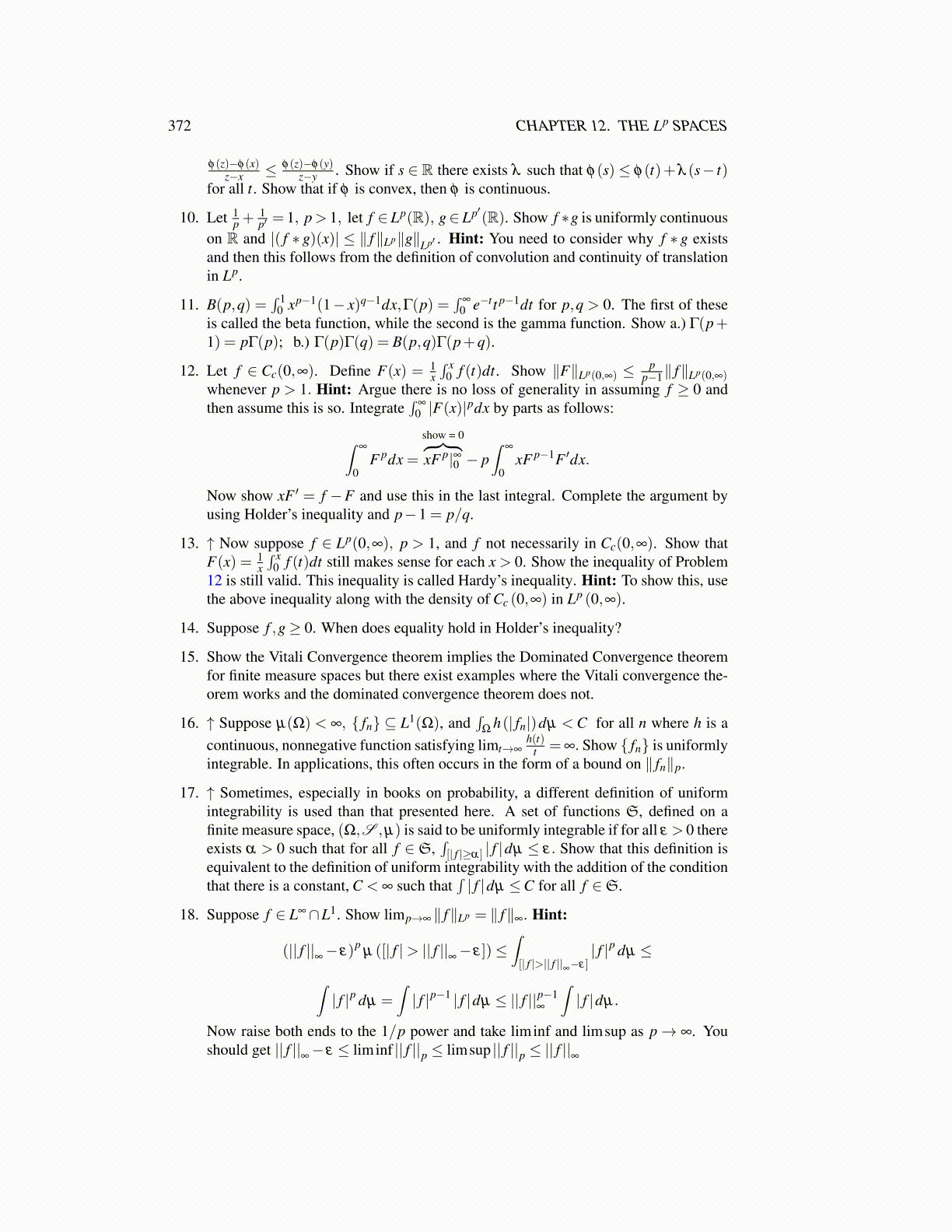
372 CHAPTER 12. THE Lp SPACES
φ(z)−φ(x)z−x ≤ φ(z)−φ(y)
z−y . Show if s ∈ R there exists λ such that φ(s) ≤ φ(t)+λ (s− t)for all t. Show that if φ is convex, then φ is continuous.
10. Let 1p +
1p′ = 1, p> 1, let f ∈ Lp(R), g∈ Lp′(R). Show f ∗g is uniformly continuous
on R and |( f ∗ g)(x)| ≤ ∥ f∥Lp∥g∥Lp′ . Hint: You need to consider why f ∗ g existsand then this follows from the definition of convolution and continuity of translationin Lp.
11. B(p,q) =∫ 1
0 xp−1(1− x)q−1dx,Γ(p) =∫
∞
0 e−tt p−1dt for p,q > 0. The first of theseis called the beta function, while the second is the gamma function. Show a.) Γ(p+1) = pΓ(p); b.) Γ(p)Γ(q) = B(p,q)Γ(p+q).
12. Let f ∈ Cc(0,∞). Define F(x) = 1x∫ x
0 f (t)dt. Show ∥F∥Lp(0,∞) ≤ pp−1∥ f∥Lp(0,∞)
whenever p > 1. Hint: Argue there is no loss of generality in assuming f ≥ 0 andthen assume this is so. Integrate
∫∞
0 |F(x)|pdx by parts as follows:
∫∞
0F pdx =
show = 0︷ ︸︸ ︷xF p|∞0 − p
∫∞
0xF p−1F ′dx.
Now show xF ′ = f −F and use this in the last integral. Complete the argument byusing Holder’s inequality and p−1 = p/q.
13. ↑ Now suppose f ∈ Lp(0,∞), p > 1, and f not necessarily in Cc(0,∞). Show thatF(x) = 1
x∫ x
0 f (t)dt still makes sense for each x > 0. Show the inequality of Problem12 is still valid. This inequality is called Hardy’s inequality. Hint: To show this, usethe above inequality along with the density of Cc (0,∞) in Lp (0,∞).
14. Suppose f ,g≥ 0. When does equality hold in Holder’s inequality?
15. Show the Vitali Convergence theorem implies the Dominated Convergence theoremfor finite measure spaces but there exist examples where the Vitali convergence the-orem works and the dominated convergence theorem does not.
16. ↑ Suppose µ(Ω) < ∞, { fn} ⊆ L1(Ω), and∫
Ωh(| fn|)dµ < C for all n where h is a
continuous, nonnegative function satisfying limt→∞h(t)
t =∞. Show { fn} is uniformlyintegrable. In applications, this often occurs in the form of a bound on ∥ fn∥p.
17. ↑ Sometimes, especially in books on probability, a different definition of uniformintegrability is used than that presented here. A set of functions S, defined on afinite measure space, (Ω,S ,µ) is said to be uniformly integrable if for all ε > 0 thereexists α > 0 such that for all f ∈S,
∫[| f |≥α] | f |dµ ≤ ε. Show that this definition is
equivalent to the definition of uniform integrability with the addition of the conditionthat there is a constant, C < ∞ such that
∫| f |dµ ≤C for all f ∈S.
18. Suppose f ∈ L∞∩L1. Show limp→∞ ∥ f∥Lp = ∥ f∥∞. Hint:
(|| f ||∞− ε)p
µ ([| f |> || f ||∞− ε])≤
∫[| f |>|| f ||∞−ε]
| f |p dµ ≤
∫| f |p dµ =
∫| f |p−1 | f |dµ ≤ || f ||p−1
∞
∫| f |dµ.
Now raise both ends to the 1/p power and take liminf and limsup as p→ ∞. Youshould get || f ||
∞− ε ≤ liminf || f ||p ≤ limsup || f ||p ≤ || f ||∞